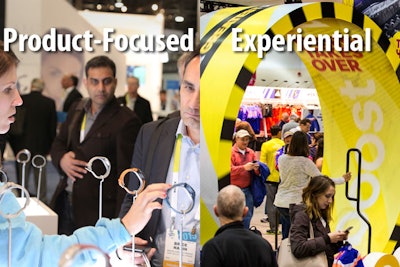
Booth space on an exhibit hall floor is a blank canvas, and savvy planners know that the right design can take a brand from being just another stop along the aisle to being a destination for attendees. Getting people excited enough to visit the booth, learn about the brand’s offerings, and maybe even talk sales is the ultimate goal for exhibit managers.
To that end, should a display draw attention to the product, or will an experiential design aimed at drawing in buyers be more effective? Trade show experts weigh in on the pros and cons of the two options.
Product-Focus Displays
“It’s [a way of] simplifying the marketing message,” says Jeff Provost, executive director of the Exhibit Designers & Producers Association in Norwalk, Connecticut.
But since product-based displays are more common in business-to-consumer environments, the biggest hazard an exhibit manager faces is that there will be too many messages competing for the audience’s attention.
“It’s the job of the builder to take what’s in many cases a confusing marketing message to its one essential,” he says. “If it can be simplified to the basic need and drive, that’s the trick.”
Today’s technology has allowed exhibitors to do this using traditional methods, but in new ways. For example, printing advances let booth designers spread their message across a dizzying array of surfaces.
“I can print rugs, tile, and wallpapers. I can print on metal, wood—I can take almost any type of material out there,” says Glenda Brungardt, trade show and event manager for Hewlett Packard Printing and Personal Systems Americas. “I think the product drives how the design should be done.”
In addition, flat-screen “walls” can communicate a wider variety of brand messages than static ones, Provost says. “That’s really where technology has advanced for our industry. You’re creating a space for the brand to come to life.”
The ubiquitous adoption of flat screens and tablets gives planners much more versatility, since digital content can be rotated, maximizing the amount of brand messaging an exhibitor can do. Provost says brands with a large number of products, or who need to tailor messages to different audiences, benefit most from digital displays.
Aside from technology, elements like color, shape, and lighting make a strong impression on an audience, even if guests don’t realize it. “Lighting and coloring can often be overlooked, but they can be used very effectively and inexpensively,” says Jacqueline Beaulieu, executive director of healthcare education and events at Worcester, Massachusetts-based BlueHive Strategic Environments.
“One of the things we really look at is materiality and form factor: How do we literally take elements from the product and imbue the booth design with them?” says Mark Robison, senior vice president of experience strategy at Sparks Marketing Group.
Experiential Design
Trade show pros say getting a product or tool into buyers’ hands is a highly effective marketing tactic. “If you get them hands-on, you’ve got buy-in,” says Candy Adams, founder of Trade Show Consulting.
Especially in fields like technology where the “product” is little more than lines of code, giving trade show attendees a visual and tactile experience via demos or hands-on time is a crucial activity. “When people walk away, they remember what they did, not what they saw,” Adams says. “They remember the experience.”
At an Adidas exhibit at the Boston Marathon’s pre-race expo, Sparks added an experiential element by letting attendees test out the kicks by running on a human-size hamster wheel in the booth. “We created an environment that was a metaphor of the technology for the shoe,” says Sparks vice president of creative Erik Weber.
There are, however, design considerations to keep in mind for planners who want an experiential booth. For starters, if there are product demos or presentations, hosts will need to give people a place to sit—and make sure it’s comfortable.
For a seven-minute presentation Adams’s client DB Networks held in its booth at the RSA Conference, an IT security event, she rented padded ottomans that attendees could sit on. Seating was a must—even though it wasn’t cheap. “We had padded hassocks, like an ottoman or stool,” Adams says. The rental fee per seat was about $80, she says, but the comfort factor was worth it.
Plus, if planners run a hands-on demonstration, there needs to be enough space for people to fiddle with the devices or tools on offer. “You need a booth space that allows for what your plan is,” Beaulieu says. For instance, placing the hands-on area right at the front could block traffic. Also, larger booths may require additional screens that project an up-close view of the presenters to help keep the audience engaged, Adams adds.














![For the after-party, Event Eleven built three 30-foot pagodas and hung 300 lanterns from the ceiling. They also brought in a 20-foot-tall bonsai tree and a variety of 30-foot red maples, along with other greenery and foliage. '[It all] helped create the organic atmosphere and helped transport guests into a gardenlike room,' said Schubert.](https://img.bizbash.com/files/base/bizbash/bzb/image/2024/02/Shogun.41_f.65dba8f23433b.png?auto=format%2Ccompress&fit=crop&h=112&q=70&w=112)




